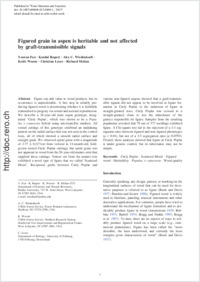Figured grain in aspen is heritable and not affected by graft-transmissible signals
- Fan, Youran Department of Forestry and Natural Resources, Purdue University, West Lafayette USA
- Rupert, Kendal Department of Forestry and Natural Resources, Purdue University, West Lafayette USA
- Wiedenhoeft, Alex C. USDA Forest Service, Forest Products Laboratory, Madison, USA
- Woeste, Keith Department of Forestry and Natural Resources, Purdue University, West Lafayette USA - USDA Forest Service, Northern Research Station, Hardwood Tree Improvement and Regeneration Center, West Lafayette, USA
- Lexer, Christian Department of Biology, University of Fribourg, Switzerland
- Meilan, Richard Department of Forestry and Natural Resources, Purdue University, West Lafayette USA
-
12.02.2013
Published in:
- Trees Structure and Function. - 2013, vol. 27, no. 4, p. 973-983
English
Figure can add value to wood products, but its occurrence is unpredictable. A first step in reliably producing figured wood is determining whether it is faithfully transmitted to progeny via sexual and asexual reproduction. We describe a 26-year-old male aspen genotype, designated ‘Curly Poplar’, which was shown to be a Populus × canescens hybrid using microsatellite markers. All rooted cuttings of this genotype exhibited an undulating pattern on the radial surface that was not seen in the control trees, all of which showed a smooth radial surface and straight grain. We observed spiral grain with a magnitude of 2.77 ± 0.12°/cm from vertical in 11-month-old, field-grown rooted Curly Poplar cuttings, but spiral grain was not apparent in wood from the 26-year-old mature ortet that supplied these cuttings. Veneer cut from the mature tree exhibited a novel type of figure that we called ‘Scattered Moiré’. Reciprocal grafts between Curly Poplar and various non-figured aspens showed that a graft-transmissible signals did not appear to be involved in figure formation in Curly Poplar or the induction of figure in straight-grained trees. Curly Poplar was crossed to a straight-grained clone to test the inheritance of the gene(s) responsible for figure. Samples from the resulting population revealed that 79 out of 377 seedlings exhibited figure. A Chi-square test led to the rejection of a 1:1 segregation ratio between figured and non-figured phenotypes (p < 0.01), but not of a 1:3 segregation ratio (p 0.0793). Overall, these analyses showed that figure in Curly Poplar is under genetic control, but its inheritance may not be simple.
- Faculty
- Faculté des sciences et de médecine
- Department
- Département de Biologie
- Language
-
- English
- Classification
- Biological sciences
- License
-
License undefined
- Identifiers
-
- RERO DOC 31839
- DOI 10.1007/s00468-013-0849-1
- Persistent URL
- https://folia.unifr.ch/unifr/documents/302867
Statistics
Document views: 89
File downloads:
- pdf: 188
